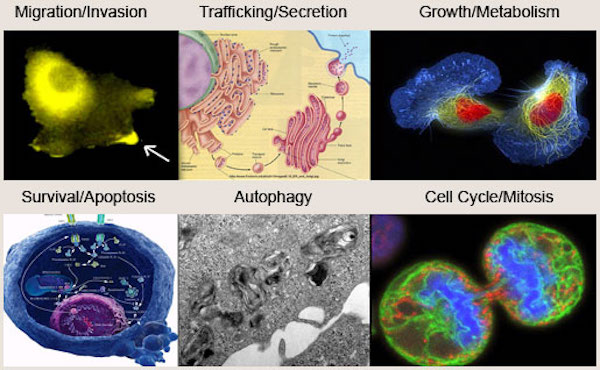Ongoing Projects
Projects/Areas of Current Interests Available For Trainees
Specific projects/areas of current interests available for trainees:
- G proteins as decision points in macrophage polarization and the innate immune response: Inflammatory bowel diseases (IBD; Crohn's disease and ulcerative colitis) are devastating conditions that affect 1 million people in the US and for which no lasting therapy currently exists. Several treatments for IBD aim to reduce inflammation by targeting inflammatory effectors, but none target dysfunctional macrophages. Because the molecular mechanisms that govern inflammatory responses in macrophages are not fully elucidated or exploited as therapeutic targets, there is a need that is both urgent and unmet. Using a combination of biochemical, cell biological, RNA-sequencing, and primary cell culture approaches we have identified GIV, a non-receptor GEF essential for the TLR4-G-protein signaling axis, as a key determinant of macrophage polarization and inflammatory cytokine production. As cell biologists, we intend to chart out the various steps during pathogen engulfment and clearance (via phagolysosomal maturation) that are regulated by GEMs, and interrogate mechanisms by which pathogens hijack the pathway to escape such clearance. Preliminary results have established the GIV→Gai signaling axis as a central signaling pathway in macrophage inflammatory responses and for bacterial uptake and clearance, and provide proof-of-principle for therapeutic targeting of GIV-GEF in IBD.
- G proteins in injury, inflammation and repair: This project entails understanding the role of GIV in serving as a central hub that simultaneously amplifies pro-fibrogenic and down-regulates anti-fibrogenic signals in specialized myofibroblasts (hepatic stellate cells) during liver fibrosis and cirrhosis. Specifically, in this project we seek to elucidate the role of G proteins in modulating signals downstream of receptors that are known to enhance fibrogenic programs (TGFbeta, PDGF, TLR4, IL17) and how these receptors use GIV and/or Daple GEMs to alter downstream signaling cascades. We use human specimens for pathologic studies and additionally work with zebrafish as a model of chronic liver disease, simulating the pro-fibrogenic effect of alcohol abuse. Additionally, we are generating GIV knockout hepatic stellate cells using Crispr/Cas9 to further delineate its effect in various receptor downstreampathways.
- G proteins in the regulation of planar cell polarity, and implications during development and in cancer: This project involves understanding how the signaling scaffold, Daple (the second member of the GEM family), has two opposing functions during colorectal cancer progression; it serves as a tumor suppressor during the initial stages, but switches to an oncogene during late stage cancer progression. Using both zebrafish and cellular models of colorectal cancer, we seek to address if differential localization and/or post-translational modification of Daple controls this switch. Furthermore, proteomic studies on Daple-interacting proteins, identified by proximity labeling, have revealed novel binding partners, which provide valuable and exciting clues to the role of Daple in cells. Several of these findings promise a tectonic shift [BK1] amongst paradigms in signal transduction.
- Structural basis for the action of GEMs, and their potential as druggable targets: Signals initiated by multiple Receptor Tyrosine Kinases (RTKs) converge on the protein Gα- Interacting Vesicle associated protein (GIV) to trigger non-canonical transactivation of the trimeric G protein Gαi, the consequences of which have been demonstrated to be far-reaching and important for a diverse set of biological processes in both health and disease. Despite insights gained, the structural basis for this unusual G protein activation by GIV has remained a mystery and as such, drug development to target this pathway for therapeutic intervention in a wide variety of diseases has thus far not been possible. Ongoing work in the lab utilizes x-ray crystallography, enzymology, differential scanning fluorimetry, and various biochemical approaches to investigate the structural basis for GIV-dependent G protein activation at the atomic level. These structural insights are now allowing us, in collaboration with the Sanford Burnham Prebys drug discovery team, to conduct targeted high-throughput screening for the development of small molecule drugs to disrupt this RTK-GIV-Gαi pathway in human disease.
- Structure-based identification of novel GEMs in the human genome: Using the solved structure (above), we have identified a few other putative GEMs in the human genome-these are proteins engaged in diverse cellular processes and signaling within distinct pathways. Some already have disease associations [via GWAS studies], whereas others have been found to be critical signal transducers whose aberrations are associated with multiple diseases.
- Other projects studying the role of GEMs and the G proteins in cellular processes: Our lab continues to explore the roles of GEMs at various places within cells, and the impact of such localization and their G protein regulatory effect on various cellular processes at those locations. Some of the ongoing projects include: a) polarized exocytosis; b) DNA damage repair; c) mitochondrial dynamics; d) cell-cell junctions and epithelial barrier function.
New Horizons
As cell biologists, we are poised to continue to dissect the fundamentals of this new pathway using functional assays. Incoming postdocs are encouraged to open new directions. Having discovered this pathway, our in-depth understanding of it can be leveraged while leading collaborative efforts with other experts. Most important of all, my knowledge of medicine makes me uniquely qualified to seamlessly translate our discoveries from bench-to-bedside, whichever direction our findings take us.
For example, concluded work has already revealed the therapeutic and diagnostic potential of this pathway, in diseases ranging from cancer, through organ fibrosis, to diabetes, with more to come. Ongoing studies should reveal the further importance of this pathway in settings such as HIV infection, aging, infertility, schizophrenia, Alzheimers and others.

